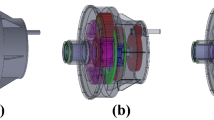Abstract
Information technologies and the web are challenging, and changing theway industry works. It is believed that web-based 3D interface can be applied to strengthen the interactive visualization and manipulation of products. In this research, a web-based 3D virtual technologies for developing product information framework is applied in automotive electric system. It is very convenient to share with different partners (e.g., co-designers, manufacturers, customers, etc.) via the web for viewing the aesthetic functions, and verifying its related design functions. The overall procedures are listed: First, build CAD models of automotive electric system (including assemble parts and their components) through CAD system, then store them in a relational database. Second, transforming the CAD models users click into virtual reality modeling language (VRML) objects, it can be visualized graphically and animated interactively using a web browser with a VRML plug-in. Finally, operate the VRML objects by Java Language for the different purposes. Due to the technologies that are applied, many interactive modes are generated in cyberspace. Displaying the exploding process of 3D assemble part on the browser, assigning any component of assemble part through the mouse chick directly to display design details, e.g., dimensions, tolerances, datum planes, material, other references, etc. by retrieving the corresponding data from database, and building 2D projected views automatically follow the 3D viewpoint that users assign.
Similar content being viewed by others
References
CIMdata (1997) Product data management: the definition, an introduction to concepts benefits, and terminology, 4th edn. CIMdata Inc, Ann Arbor, MI
Rezayat M (2000) The enterprise-web portal for life-cycle support. Comput Aided Des 32:85–96
Bender M, Klein R, Disch A, Ebert A (2000) A functional framework for web-based information visualization systems. IEEE Tans Visual Comput Graph 6(1):8–23
Hendin O, John N, Shochet O (1997) Medical volume rendering over the WWW using VRML and JAVA. Proc MMVR
Sowizral HA, Deering MF (1999) The java 3D API and virtual reality. IEEE Comput Graph Appl 19(3):12–15
The ecma international, standards@internet speed, available fromhttp://www.ecma-international.org, Site visited in July 2004
Krueger M (1991) Artificial reality II. Addison-Wesley, Reading, MA
Chen YM, Tsao TH (1998) A structure methodology for implementing engineering data managemet. Robot Comput Integr Manuf 14(3):275–296
Miller E (1998) PDM in the forefront. Comput Aided Eng 17(3):30–42
Lebovitz PP (1997) Design data management for the small engineering shop. Mach Des, pp 20–26
Peltonen H, Pitkanen O, Sulonen R (1996) Process-based view of product data management. Comput Ind 31(2):195–203
Vinoid B, Gevins J, Baudin C, Mabogunje A, Toye G, Leifer L (1992) An experimental study of design information reuse. Proc 4th International Conference on Design Theory and Methodology. ASME, 13–16 September, Scotts-dale, AZ, pp 141–147
Kvan T, Candy L (2000) Designing collaborative environment for strategic knowledge in design. Knowl-based Syst 9(2):429–438
Wood WH III, Agogino AM (1996) Case-based conceptual design information server for concurrent engineering. Comput Aided Des 28(5):361–369
Dolenc A, Makela I (1997) Text analysis for constructing design representations. Artif Intell Eng 11(1):65–75
Saad M, Maher ML (1996) Shared understanding in computer-supported collaborative design. Comput Aided Des 28(1):183–192
Ginsburg M, Kambil A (1999) A web-based knowledge management support system for document collections. Proc 32nd Hawaii Conference on system Sciences, pp 1–10
Sun Developer Network-Java 3D API, available from: http://java.sun.com/products/java-media/3D/>, Site visited in July 2004
Author information
Authors and Affiliations
Corresponding author
Rights and permissions
About this article
Cite this article
Liang, J.S. A web-based 3D virtual technologies for developing product information framework. Int J Adv Manuf Technol 34, 617–630 (2007). https://doi.org/10.1007/s00170-006-0627-y
Received:
Accepted:
Published:
Issue Date:
DOI: https://doi.org/10.1007/s00170-006-0627-y




